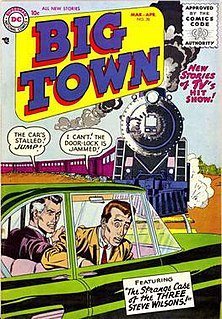Notes and references
Notes
- ↑ Robert Herzberg (né Robert Albert George Herzberg; 1886–1960) was a German-born American painter and illustrator.
- ↑ The Dayton Herald carried the supplement on Wednesdays as the Mid-Week Screen & Radio Magazine.
- ↑ The Daily Times, Chicago, carried the supplement on Sundays as the Screen & Radio Magazine.
Related Research Articles
The following are the Pulitzer Prizes for 1932.

Big Town is a popular long-running radio drama featuring a corruption-fighting newspaper editor initially played from 1937 to 1942 by Edward G. Robinson in his first radio role, with echoes of the conscience-stricken tabloid editor he had played in the film Five Star Final. Edward Pawley played the lead role longer, 1943–52, in plots that made the editor more of a hands-on crime-fighter. During the later Pawley years, Big Town was adapted to film and television series, and a comic book published by DC Comics.

The Detroit Free Press is the largest daily newspaper in Detroit, Michigan, US. The Sunday edition is titled the Sunday Free Press. It is sometimes referred to as the Freep. It primarily serves Wayne, Oakland, Macomb, Livingston, Washtenaw, and Monroe counties.

The Detroit News is one of the two major newspapers in the U.S. city of Detroit, Michigan. The paper began in 1873, when it rented space in the rival Detroit Free Press's building. The News absorbed the Detroit Tribune on February 1, 1919, the Detroit Journal on July 21, 1922, and on November 7, 1960, it bought and closed the faltering Detroit Times. However, it retained the Times' building, which it used as a printing plant until 1975, when a new facility opened in Sterling Heights. The Times building was demolished in 1978. The street in downtown Detroit where the Times building once stood is still called "Times Square." The Evening News Association, owner of The News, merged with Gannett in 1985.

Adrienne Ames was an American film actress. Early in her career she was known as Adrienne Truex.

The Flint Journal is a quad-weekly newspaper based in Flint, Michigan, owned by Booth Newspapers, a subsidiary of Advance Publications. Published Tuesdays, Thursdays, Fridays and Sundays, it serves Genesee, Lapeer and Shiawassee Counties. As of February 2, 2012, it is headquartered in Downtown Flint at 540 S Saginaw St, Suite 504. The paper and its sister publications The Saginaw News and The Bay City Times are printed at the Booth-owned Valley Publishing Co. printing plant in Monitor Township.
The byline on a newspaper or magazine article gives the name of the writer of the article. Bylines are commonly placed between the headline and the text of the article, although some magazines place bylines at the bottom of the page to leave more room for graphical elements around the headline.
The Bramptonian was a short-lived Brampton, Ontario newspaper created 1984. The husband and wife team John and Judi McLeod founded the newspaper to rival The Brampton Times.

Virginia Brown Faire was an American silent film actress, appearing in dramatic films and, later, in sound westerns.

Kathleen B. Burke was an American movie actress of the 1930s and former model.

Raquel Torres was a Mexican-born American film actress. Her sister was actress Renee Torres.

She Couldn't Take It is a 1935 screwball comedy film made at Columbia Pictures, directed by Tay Garnett, written by C. Graham Baker, Gene Towne and Oliver H.P. Garrett, and starring George Raft and Joan Bennett. It was one of the few comedies Raft made in his career.

Patricia Ellis was an American film actress of the 1930s.

Julie Gibson was an American singer and radio, television and film actress who had a career in movies during the 1940s. Gibson, who retired from the industry in 1984, was known for her work opposite The Three Stooges. She also collaborated with Orson Welles, John Huston, Ida Lupino and The Bowery Boys.
Irina Petrushova is a Russian journalist, founder and editor-in-chief of the weekly Respublika in Kazakhstan. After a series of stories exposing government corruption, her life was threatened and her paper firebombed. In 2002, she was awarded a CPJ International Press Freedom Award.
John Jacob Sher was an American newspaper columnist, songwriter, film director, film writer, and producer.
Loretta Lee was an American singer in the first half of the 20th century.

Katie Joplin is an American sitcom created by Tom Seeley and Norm Gunzenhauser that aired for one season on The WB Television Network from August to September 1999. Park Overall stars as the title character, a single mother who moves from Knoxville to Philadelphia and tries to balance her job as a radio program host with parenting her teenage son Greg. Supporting characters include Katie's niece Liz Berlin as well as her co-workers, played by Jay Thomas, Jim Rash, and Simon Rex. Majandra Delfino guest-starred in three episodes as the daughter of the radio station's general manager.
Robert Mero Kalloch III, often known by his professional mononym Kalloch, was an American fashion designer and, later, a costume designer for Columbia Pictures and Metro-Goldwyn-Mayer. He worked on 105 films during his career, and was widely considered one of America's top fashion designers in the late 1930s.
Bernadine Hayes was an American singer and an actress on radio and stage and in films and vaudeville. In 1930, she was named the most beautiful radio performer in America.
References
- 1 2 ("Screen & Radio Weekly")Time, Vol. 25, Part 2, p. 55 (Retrieved via Google Books; snippet view only)
- ↑ "Detroit Gives Enthusiastic Welcome to Free Press Screen & Radio Weekly,"Detroit Free Press, April 30, 1934, p. 4 (Retrieved via Newspapers.com ; subscription required)
- ↑ Complete Biographical Encyclopedia of Pulitzer Prize Winners, 1917–2000, by Heinz-Dietrich Fischer, Erika J. Fischer, K. G. Saur Verlag, (2002); ISBN 3-598-30170-7 "Martin, Douglas DeVeny", pp. 153–154
- ↑ On Guard, A History of the 'Detroit Free Press,' by Frank Angelo, Detroit Free Press (1981), p. 158; OCLC 7273946
- 1 2 "Screen & Radio Weekly" (review), The Writer, Vol. 52 (issue not known) (1939), p. 384 (Retrieved via Google Books; snippet view only)
- ↑ Rochester's Movie Mania, by Donovan A. Shilling (born 1933), (self published) (2013), p. 38 (2013); OCLC 856579424 Note: Shilling is historian, notably on Rochester, New York
- ↑ ("Screen & Radio Weekly") Printers' Ink, Vol. 171 (issue not known), 1935; ISSN 0196-1160 (Retrieved via Google Books; snippet view only)
- ↑ "Death Notices – 'Richards, Sara Lou (Dague),'" Hartford Courant, August 18, 2001, p. B4 (Retrieved via Newspapers.com ; subscription required)
- ↑ "Miss Grace M. Barber . . . " (marriages), Detroit Free Press, July 10, 1921, part 4, p. 4, col. 7 (of 8, top) ( Newspapers.com ; subscription required)
- ↑ "Grace Barber to Get Award" Detroit Free Press, February 7, 1960, p. 10E ( Newspapers.com ; subscription required)
- ↑ "A Woman of Words and Fishing Rods," by Kay Savage," p. 1E (accessible via Newspapers.com , subscription required)Continued, "Grace Barber, Her 2 Lives," Detroit Free Press, February 7, 1960, p. 10E ( Newspapers.com ; subscription required)
- ↑ Jacobsen's Biographical Index of American Artists – Artists native to the United States or working in the United States from 1606 to 2002 (Vol. 2 of 4), Anita Jacobsen (ed.) A.J. Publications (2002); OCLC 956672085
- ↑ The Coryell Nursery – Growers of High Grade Ornementals (1917)
- ↑ "A Designing Young Lady – Lillian Templeton, Studio Stylist, Discusses the Art of Garbing the Garbos," by Frank Stanley Nugent, New York Times, May 19, 1935, p. 4X (Retrieved via New York Times , subscription required)
- ↑ California and Californians (Vol. 4 of 4), Rockwell Dennis Hunt, PhD (ed.), Lewis Publishing Company (1932), p. 533
- ↑ "Sixty-Eighth Annual Commencement," Northwestern University, June 14, 1926, pp. 13 & 24
- ↑ "Isabella Taves Miller Joins Look Staff," (re: Look)Nebraska State Journal, May 28, 1942, p. 5 (Retrieved via Newspapers.com ; subscription required)
- ↑ ("Mrs. Isabella Miller") Printers' Ink, Vol. 177 (issue not known), 1936, p. 40; ISSN 0196-1160 (Retrieved via Google Books; snippet view only)
- ↑ "From the Production Centres – In Hollywood . . . " (re: "Grace Wilcox"), Variety, Vol. 155, No. 5, July 12, 1944, p. 26
- 1 2 "Deaths: Robert Burns White," The Times Herald (Port Huron, Michigan), August 26, 1969, p. Sec. A, p. 5 (accessible via Newspapers.com ; subscription required)
- ↑ "Radio Editors of Newspapers in the United States and Canada," Broadcasting combined with Broadcast Advertising – 1936 Year Book Number, Broadcasting Publications, Inc.
- ↑ "Startled Miss Sloan Reads Own 'Murder' – Mystery Tale Reviewer Finds Out How She 'Died'" (book review), by Betty Sloan, Detroit Free Press, May 12, 1935, part 3 "Arts Section," p. 13 (accessible via Newspapers.com ; subscription required)
- ↑ "Joins NBC – Robert White" (with portrait photo), Detroit Free Press, September 19, 1937, p. 19, col. 6 (of 8) (Retrieved via Newspapers.com ; subscription required)
- ↑ "Front Office – Robert Burns White," Broadcasting, October 9, 1950, p. 50